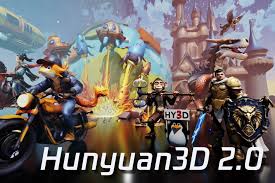Tencent Advances 3D Generative AI, Pushing Boundaries with Novel Open-Source Techniques
Editor
Jun 22, 2025
min read
4 views

SHENZHEN – While the world has been captivated by AI that generates text and images, Chinese tech giant Tencent has been quietly making significant strides in the far more complex domain of 3D content generation. Through its various research arms, including the Tencent ARC lab, the company has been developing and, in many cases, open-sourcing a collection of innovative models and techniques aimed at creating high-quality, scalable 3D assets from various inputs like text, images, and even videos. Although there isn't one single, all-encompassing project named 'Dream3D', Tencent's collective efforts represent a powerful push to democratize 3D creation. One of the core challenges in 3D generative AI is the scarcity of high-quality 3D data for training. To overcome this, Tencent researchers have developed novel paradigms. For instance, their 'VFusion3D' project leverages pre-trained video diffusion models. By fine-tuning these powerful 2D video models, they can generate large-scale synthetic multi-view datasets, which are then used to train a feed-forward 3D generative model capable of creating a 3D asset from a single image in seconds. Another innovative approach is seen in 'Squeeze3D', a framework that cleverly uses the implicit knowledge within existing pre-trained 3D generative models to act as an extreme neural compressor. This allows for the representation of complex 3D models as highly compact latent codes, which can be efficiently stored and then decompressed back into full 3D models by a powerful generative model. This technique is trained entirely on synthetic data, again bypassing the need for massive, curated 3D datasets. Tencent is also tackling the challenge of creating entire 3D worlds. Their 'SynCity' project is a training-free approach that combines the geometric precision of 3D generative models with the artistic flair of 2D image generators. Using a tile-based method, SynCity allows for the creation of large, high-quality 3D spaces with fine-grained control over layout and appearance, moving beyond the object-centric focus of most current 3D generators. Furthermore, Tencent is pioneering methods for inverse procedural content generation (PCG). Their 'DI-PCG' model uses a lightweight diffusion transformer to reverse-engineer the parameters of a procedural engine from a single image. This allows a user to show the AI a picture of a building, for example, and the model can generate the procedural code needed to create that building in a 3D environment, offering a new bridge between 2D concepts and 3D creation. These projects, often published in top-tier academic conferences and accompanied by open-source code, are contributing valuable tools and methodologies to the global research community. By focusing on data-efficient training methods, scalability, and novel architectures, Tencent is not just building proprietary technology but is also laying the groundwork for the next generation of 3D content creation in gaming, virtual reality, and the metaverse.
Editor
League Manager Editorial Team





Leave a Comment